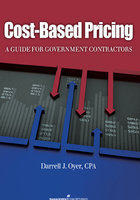
Preface
Cost-based pricing refers to the practice of estimating prices based on estimated cost plus a reasonable profit, as opposed to estimating a price based on the value received and other market circumstances. In government contracting, this distinction is significant, in that most government personnel and most regulations greatly favor using cost-based pricing. Cost-based pricing is necessitated by the government’s inability to purchase all needed goods and services in a commercial market. Until World War I, the government could purchase everything it needed in a commercial pricing environment; the advent of complex weapon systems not for sale in a commercial market required a cost-based pricing approach.
This book is intended to be used primarily by price estimators but also by pricing managers, business development personnel, accountants, subcontract administrators, and contract negotiators—in summary, anyone involved in the process of estimating and negotiating contract prices. Mastery of each topic is necessary to develop a complete pricing proposal.
Price estimating is not a common topic in college curricula, which train accountants to be auditors and accountants but not to be price estimators or pricing specialists. Yet in the government contracting environment, accountants are often required to do as much estimating as they do cost accounting. Most cost-estimating techniques are learned through on-the-job training and specialty courses designed strictly for government contract-estimating situations. This book is a response to the resulting need for a general description of the entire pricing process that will directly assist personnel in preparing or reviewing cost-based proposals. Its purpose is to review the practical techniques involved in estimating costs and prices for federal government contracts, with a heavy focus on cost-based pricing. In addition to the practical aspects of cost estimating, this book deals with requirements in the Federal Acquisition Regulation (FAR) Part 15 and issues arising from proposal reviews by government auditors and other reviewers. Use of this book will save time for contractors and will result in better-prepared and more defensible cost proposals.
Although cost-based prices dominate in the pricing of government contracts, estimating prices for government contracts involves both cost-based and market-based prices. Cost-based pricing pertains to cost reimbursement contracts and fixed price contracts that do not result from competition, because federal funds may be used by the state or local government in awarding a contract. Market-based pricing is less common in government contracts but is appropriate for commercial items purchased by the government. Because market-based pricing techniques are well established for commercial purposes, they are a secondary focus of this book.
This preface provides an introduction to the general topic of cost-based pricing. Chapter 1 explains basic pricing concepts and details the differences between cost-based pricing and other types of pricing. Chapters 2 through 6 address the cost elements that make up a cost-based price: (1) direct labor, (2) direct materials and subcontracts, (3) indirect costs, (4) other direct costs, and (5) facilities capital cost of money. Indirect costs consist of overhead and “general and administrative” expenses. Contractors may, of course, have more than one overhead pool, but each business unit may have only one general and administrative cost pool. This book does not address in detail the concepts of establishing direct costs versus indirect costs or establishing an indirect cost structure. An indirect cost structure is established in the types and number of indirect-cost pools needed to properly allocate indirect costs. For the purposes of this book, it is assumed that a company preparing a proposal already has these policies and procedures in place. If the reader needs further instruction regarding these policies and procedures, textbooks discussing how to distinguish between direct and indirect costs and how to establish an indirect cost structure are available.
Chapter 7 addresses the concept of markup, also known as profit or fee—specifically, the amount of profit or fee generally accepted by the government for the various contracting circumstances. Chapter 8 reviews requirements imposed by the FAR regarding the submission of price proposals, with Table 15-2 of the FAR (Instructions for Submitting Cost/Price Proposals When Certified Cost or Pricing Data Are Required) covered in detail. Other concepts addressed in this chapter are consistency of accounting practices as established by the FAR, the Cost Accounting Standards (CAS), and the CAS Board disclosure statement; government concerns regarding cost; and price realism (e.g., pricing too low). The fundamental FAR and CAS principles require consistency between estimating and recording costs; thus, the topics of estimating and cost accounting are intertwined.
Pricing contract modifications are discussed in detail in Chapter 9. Contract modifications are important in assuring maintenance of appropriate profit levels; a contractor who accepts changes in the form of increased work without compensation reduces profits unreasonably. Chapter 10 provides an extensive discussion of improvement curves. A basic principle of estimating labor hours is the concept that labor hours decrease as additional quantities are produced. Chapter 11 describes market- or value-based pricing; the FAR is clearly deficient in describing these methods. Chapter 12 describes Defense Contract Audit Agency (DCAA) audit guidance on review of proposals. This guidance is contained in the DCAA Contract Audit Manual and has been modified frequently in recent years as a result of pressures on DCAA to be more aggressive during proposal reviews. Chapter 13 addresses the requirements of the Truth-in-Negotiations Act and techniques for avoiding allegations of defective pricing. This legislation establishes a basis for price adjustments if a contractor does not disclose all current, accurate, and complete cost or pricing data. This topic is most important to those personnel negotiating prices with the government.
Darrell J. Oyer, CPA
January 2012